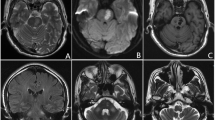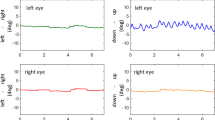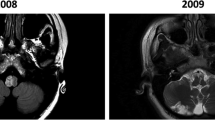Summary
A report is given on 29 cases of olivary hypertrophy of different origin with special reference to the quality and topistic distribution of olivary degeneration in relation to the dating and site of the primary lesion. All except one case of hypertrophic degeneration of the inferior olive resulted from injury to the dentato-olivary pathway; 13 were associated with an isolated lesion of this pathway; while in 15 cases bilateral olivary hypertrophy was secondary to multiple injury to the afferent olivary pathway. There were 12 cases of primary cerebrovascular disease, 13 cases of head injury and other lesions resulting from transtentorial herniation, and four tumours of the brain stem, one of which showed “blastomatous” olivary hypertrophy different from the usual olivary response to deafferentation. Early vacuolation of olivary neurons was seen 12 to 20 days after injury to the dentato-olivary pathway, while after longer survival olivary hypertrophy characterized by degeneration and enlargement of neurons and astroglia was associated with secondary degeneration of other parts of the dentato-olivary pathway and olivo-cerebellar tract. Correlative studies of the distribution of primary lesions and of the pattern of ensuing degeneration of inferior olives and other related structures confirmed and further defined the previously known topistic organization of the dentato-olivary pathway and the somatotopic relations between the dentate nuclei and contralateral inferior olives and the other structures involved in this neuronal circuit. The unique features of olivary hypertrophy related to transneuronal degeneration in response to deafferentation are compared with experimental data and other rare forms of olivary enlargement of blastomatous origin. Palatal myoclonus was only reported in 2 patients with old brain stem infarctions.
Zusammenfassung
Bericht über 29 Fälle von Olivenhypertrophie verschiedener Genese mit besonderer Berücksichtigung der Qualität und topischen Ausbreitung der Olivendegeneration in Abhängigkeit von Zeit und Sitz der Primärschädigung. Mit einer Ausnahme waren alle Fälle hypertrophischer Degeneration der unteren Olive durch Schädigung der dentato-olivären Bahn bedingt; 13 traten bei isolierter Läsion dieses Systems auf, während in 15 Fällen beidseitige Olivenhypertrophie als Folge multipler Läsionen des afferenten Olivensystems vorlagen. Es handelte sich um 12 Fälle primärer vasculärer Hirnschäden, 13 Fälle von Schädelhirntrauma und anderen Folgen transtentorieller Herniationsvorgänge sowie 4 Hirnstammgeschwülste, von denen einer „blastomatöse“ Hypertrophie der Oliven in Abweichung von der üblichen Reaktion der Oliven gegenüber Deafferentierung bot. Frühe Vacuolisierung der Olivenneurone wurde 12–20 Tage nach Läsionen der dentato-olivären Bahn beobachtet, während nach längeren Überlebenszeiten die durch Degeneration und Vergrößerung von Neuronen und Astrogliahyperplasie gekennzeichnete Olivenhypertrophie mit sekundärer Degeneration anderer Teile der dentato-olivären und olivo-cerebellaren Bahnen verbunden waren. Vergleichsunter-suchungen der Verteilung der Primärläsionen und des Musters der folgenden Degeneration der unteren Oliven und anderer verbundener Strukturen bestätigten und erweiterten die bekannte somatotopische Organisation des dentato-olivären Systems sowie die somatotopischen Beziehungen zwischen Zahnkern und kontralateraler unterer Olive sowie anderer in diesen Neuronenkreis eingebauter Strukturen. Die eigenartigen Merkmale der durch transneuronale Degeneration infolge Deafferentierung bedingten Olivenhypertrophie werden mit experimentellen Befunden sowie anderen seltenen Formen blastomatöser Olivenvergrößerung verglichen.
Similar content being viewed by others
References
Alajouanine, T., Thurel, R., Hornet, T.: Un cas anatomo-clinique de myoclonies velo-pharyngées et oculaires. Rev. neurol. 64, 853–872 (1935)
André-Thomas: Recherches sur le faisceau longitudinal postérieur et la substance réticulée bulbo-protubérantielle, le faisceau central de la calotte et le faisceau de Helweg. Rev. neurol. 11, 94–96 (1903)
Ben Hamida, M., Lapresle, J.: Correspondence somatotopiques chez l'homme des dégénérescences segmentaires du pédoncule cérébelleux supérieur secondaires à des lésions limitées du noyau dentelé homolatéral. Rev. neurol. 120, 263–270 (1969)
Bogaert, L. van, Bertrand, I.: Sur les myoclonies associées synchrones et rythmiques par lésions en foyer du tronc cérébral. Rev. neurol. 35, 203–214 (1928)
Cowan, W. M.: Anterograde and retrograde transneuronal degeneration in the central and peripheral neurons system. In: Contemporary research methods in neuroanatomy, W. J. H. Nauta, S. O. E. Ebbesson, Eds., pp. 217–251. Berlin-Heidelberg-New York: Springer 1970
Davison, C., Riley, H. A., Brock, S.: Rhythmical myoclonus of the muscles of the palate, larynx and other regions. Bull. neurol. Inst. N. Y. 5, 94–124 (1936)
Foix, Ch., Chavany, J., Hillemand, P.: Le syndrome myoclonique de la calotte. Rev. neurol. 33, 942–956 (1926)
Freeman, W. A.: Palatal myoclonus. Arch. Neurol. Psychiat. (Chic.) 29, 742–755 (1933)
Fuentes, C., Marty, R.: Désafférentation expérimentale de l'écorce cérébrale. Acta neuropath. (Berl.) 22, 245–256 (1972)
Garcin, R., Escourolle, R., Lapresle, J.: Syndrome de la commissure de Wernekink par malformation vasculaire. Dégénérescences olivaires et cérébelleux associées. Rev. neurol. 124, 417–430 (1971)
Garcin, R., Lapresle, J., Fardeau, M.: Myoclonies squelettiques rythmées sans nystagmus du voile. Etude anatomoclinique avec présentation d'un film cinématographique. Rev. neurol. 109, 105–114 (1963)
Gautier, J. C., Blackwood, W.: Enlargement of the inferior olivary nucleus in association with lesions of the central tegmental tract or dentate nucleus. Brain 84, 341–361 (1961)
Gerstenbrand, F., Machacek, F.: Traumatisch bedingter Uvulanystagmus. Wien. Z. Nervenheilk. 26, 293–303 (1968)
Ghetti, B., Horoupian, D., Wisniewski, H.: Neuronal response to deafferentation (Simian lateral geniculate body as a model) (abstr.). J. Neuropath. exp. Neurol. 31, 168 (1972)
Guillain, G., Mollaret, P., Bertrand, I.: Sur la lésion responsable du syndrome du tronc cérébral. Etude anatomique d'un cas démonstratif sans lésions focales. Rev. neurol. 64, 1–18 (1933)
Hauser, H. M., Kernohan, J. W.: Unusual response of the inferior olive to gliomas. J. Neuropath. exp. Neurol. 21, 70–78 (1962)
Herrmann, C., Jr., Brown, J. W.: Palatal myoclonus: a reappraisal. J. neurol. Sci. 5, 473–492 (1967)
Holmes, G., Steward, T.: On the connection of the inferior olive with the cerebellum in man. Brain 31, 125–137 (1908)
Horoupian, D. S., Ghetti, B., Wisniewski, H. M.: Retrograde transneuronal degeneration of optic fibers and their terminals in lateral geniculate nucleus of Rhesus monkey. Brain Res. 49, 257–275 (1973)
Horoupian, D. S., Wisniewski, H.: Neurofilamentous hyperplasia in inferior olivary hypertrophy. J. Neuropath. exp. Neurol. 30, 571–582 (1971)
Huhn, B., Jakob, H.: Traumatische Hirnstammläsionen mit vieljähriger Überlebensdauer. Beitrag zur Pathologie der Substantia nigra und der oralen Brückenhaube. Nervenarzt 41, 326–334 (1970)
Ionesco-Sisesti, M., Hornet, T.: Le problème du nystagmus vélopalato-oculaire. Les dégénérescences hypertrophiques systématisées du couple olivaire bulbaire consécutives aux lésions du noyau dentelé du cervelet. Rev. oto-neuro-oftal. (B. Aires) 17, 481–499 (1939)
Jellinger, K.: Blastomatöse Pseudohypertrophie der Olive bei Hirnstammgliom. Acta neuropath. (Berl.) 4, 425–430 (1965)
Jellinger, K., Seitelberger, F.: Protracted post-traumatic encephalopathy. Pathology, pathogenesis and clinical implications. J. neurol. Sci. 10, 51–94 (1970)
Klien, H.: Zur Pathologie der kontinuierlichen rhythmischen Krämpfe der Schlundmuskulatur. Zwei Fälle von Erweichungsherden im Kleinhirn. Neurol. Cbl. 26, 245–254 (1907)
Korenke, H. D.: Apallisches Syndrom ohne Großhirn-Markveränderung unter besonderer Berücksichtigung der klinisch-neuropathologischen Korrelation. Proc. 5th. Int. Congr. Neuropath., pp. 97–99. Exc. Med., I.C.S. Nr. 100, Amsterdam 1966
Krücke, W., Stochdorph, O.: Über rhythmische Myoklonien und Pseudohypertrophie einer Olive bei einer atypischen Encephalitis. Livre Jubil. Dr. L. van Bogaert, pp. 463–470. Bruxelles: Editions Acta Medica Belgica 1962
Lapresle, J.: Un nouveau cas de dégénérescence hypertrophique de l'olive bulbaire secondaire à un ramollissement limité de la calotte mésencéphalique. J. neurol. Sci. 12, 95–100 (1971)
Lapresle, J., Ben Hamida, M.: Correspondence somatotopique secteur par secteur des dégénérescences de l'olive bulbaire consécutive à de lésions limitées du noyau dentelé contralatéral. Rev. neurol. 113, 439–448 (1965)
Lapresle, J., Ben Hamida, M.: Contribution à la connaissance de la voie dento-olivaire. Presse méd. 76, 1226–1230 (1968)
Lapresle, J., Ben Hamida, M.: The dentato-olivary pathway. Somatotopic relationship between the dentate nucleus and the contralateral inferior olive. Arch. Neurol. (Chic.) 22, 135–143 (1970)
Lejonne, P., Lhermitte, J.: Atrophie olivo-rubro-cérébelleuse. Rev. neurol. 17, 109–113 (1909)
Lhermitte, F.: Le syndrome cérébelleux. Etude anatomo-clinique chez l'adulte. Rev. neurol. 98, 435–477 (1958)
Lhermitte, J., Levy, G., Trelles, J. O.: Un nouveau cas de myoclonies vélopalatines et laryngées avec étude histologique. Rev. neurol. 42, 238–247 (1935)
Lhermitte, J., Trelles, J.-O.: L'hypertrophie des olives bulbaires. Encéphale 28, 588–600 (1933)
Marie, P., Foix, Ch.: Sur la dégénération pseudo-hypertrophique de l'olive bulbaire. Rev. neurol. 11, 48–52 (1913)
Nathanson, M.: Palatal myoclonus. Arch. Neurol. Psychiat. (Chic.) 75, 285–296 (1956)
Oppenheim, H.: Über Olivendegeneration bei Atheromatose der basalen Hirnarterien. Berl. klin. Wschr. 34, 638–639 (1887)
Pinching, A. J., Powell, T. P. S.: Ultrastructural features of transneuronal degeneration in the olfactory system. J. Cell Sci. 8, 253–287 (1971)
Ransohoff, A.: Über einen Fall von Erweichung im dorsalen Theil der Brücke. Arch. Psychiat. Nervenkr. 35, 403–429 (1902)
Rondot, P., Ben Hamida, M.: Myoclonies du voile et myoclonies squélettiques. Etude clinique et anatomique. Rev. neurol. 119, 59–83 (1968)
Savitsch, E. de, Ley, R. A.: Myoclonies palato-laryngo-pharyngées au cours d'un neurinome de la région latéro-bulbaire. Rev. neurol. 67, 595–604 (1937)
Scheibel, M., Scheibel, A.: The inferior olive. J. comp. Neurol. 102, 77–132 (1955)
Shaddock, S. H., Shaddock, L. B., Black, S. P. W.: Palatal myoclonus following head injury. J. Trauma 12, 353–357 (1972)
Sohn, D., Levine, S.: Hypertrophy of the olives. A report on 43 cases. Progr. Neuropath., H. M. Zimmermann, ed., Vol. 1, pp. 202–213 (1971)
Stefani, F. H., Mehraein, P.: Beobachtung eines Gangliocytoms der Medulla oblongata. Arch. Psychiat. Nervenkr. 214, 107–115 (1971)
Torvik, A.: Transneuronal changes in the inferior olive and pontine nuclei in kittens. J. Neuropath. exp. Neurol. 15, 119 (1956)
Trelles, J.-O.: La oliva bulbar. Su estructura, funcion y patologia. Rev. Neuropsiquiat. 6, 433–521 (1943)
Trelles, J.-O.: Les myoclonies vélo-palatines. Considérations anatomiques et physiopathologiques. Rev. neurol. 119, 165–171 (1968)
Verhaart, W., Voogd, J.: Hypertrophy of the inferior olives in the cat. J. Neuropath. exp. Neurol. 21, 92–104 (1962)
Vuia, O., Rothemund, E.: L'hypertrophie de l'olive bulbaire dans le syndrome apalliques post-traumatique. Rev. neurol. 125, 373–386 (1971)
Walberg, F.: Descending connections to the inferior olive. An experimental study in the cat. J. comp. Neurol. 104, 77–173 (1956)
Walberg, F.: Light and electron microscopic studies of two cerebellar relay nuclei. In: The cerebellum in health and disease, W. S. Fields, W. D. Willis, Eds., pp. 39–62. St. Louis (Mo.): Green 1970
Walberg, F.: Does silver impregnate normal and degenerating boutons? A study based on light and electron microscopical observations of the inferior olive. Brain Res. 31, 47–65 (1971)
Walberg, F.: Further studies on silver impregnation of normal and degenerating boutons. Brain Res. 36, 353–369 (1972)
Wisotzkey, H., Cole, M.: Reversible neurofilamentous change with deafferentation of the inferior olive in the monkey (abst.). 49th. Ann. Meet. Amer. Ass. Neuropath., June 16–18 (1973)
Author information
Authors and Affiliations
Additional information
To the memory of Prof. Klara Weingarten † July 12, 1973.
Rights and permissions
About this article
Cite this article
Jellinger, K. Hypertrophy of the inferior olives. Z. Neurol. 205, 153–174 (1973). https://doi.org/10.1007/BF00316018
Received:
Issue Date:
DOI: https://doi.org/10.1007/BF00316018




